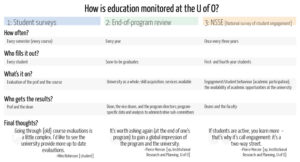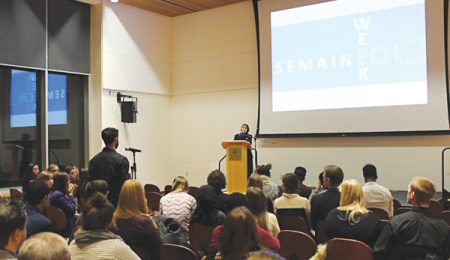 STUDENTS ARE USED to being graded. On essays, assignments, and final exams, students must synthesize and reiterate everything they’ve learned. For professors, the evaluation process is no less demanding or comprehensive.
STUDENTS ARE USED to being graded. On essays, assignments, and final exams, students must synthesize and reiterate everything they’ve learned. For professors, the evaluation process is no less demanding or comprehensive.
There are many surveys and organizations focused on monitoring the quality of education in Ontario, and at the University of Ottawa specifically, to ensure students receive a positive university experience. The evaluations measure academic experience, professor engagement, and students’ preparedness for the real-world experience.
Quality measures in Ontario
In Ontario, every university, including the U of O, has to evaluate their programs over the course of an eight-year cycle, reviewing all undergraduate programs.
This review is done through the National Survey of Student Engagement (NSSE), designed by Indiana University and used by more than 400 universities in North America. NSSE assesses quality by studying student behaviour to establish a broader understanding of the student experience, monitoring both the opportunities offered and the degree to which students use them.
NSSE, which has not yet had the desired 50 per cent participation, is distributed to students in their first and fourth year of study. Because the survey is not yet fully integrated at the U of O, it is only distributed once every three years to avoid overwhelming students.
The Higher Education Quality Council of Ontario (HEQCO), an agency of the Government of Ontario that researches post-secondary education (PSE) issues, uses qualitative analysis to assess the quality of education in Ontario’s post-secondary institutions. Richard Wiggers, research director at HEQCO, said the council has published about 80 papers on PSE.
“We have a number of research studies that are looking at what faculties are doing in their classrooms, different methods teaching large classes,” said Wiggers. “We will help fund and develop a research project that will evaluate how effective a practice is and how transferable it is to other institutions.”
Wiggers said the ultimate measure of quality is achieving the employment or lifestyle the student seeks after graduation.
Academic experience
High-quality education involves having a positive working, studying, and teaching environment. Whether research is valued over innovation in teaching, class sizes affect learning, and students are receiving skills they could apply to the workplace are all considerations that must be taken into account.
U of O professors are required to dedicate 40 per cent of their time teaching, 40 per cent to research, and 20 per cent to community service, which is a standard model across many universities according to Pierre Mercier, vp associate of Institutional Research and Planning at the U of O.
Pierre Bélanger, communications professor at the U of O, said the teaching, researching, and community service involvement of the professor all contribute to a student’s academic experience and influence one another in the classroom.
“There’s a very direct correlation between quality of teaching and quality of research,” he said. “You could be a great teacher and a great relayer of information, but doing research puts you ahead of the curve.”
Bélanger suggested class sizes only start mattering in the upper years, where theoretical knowledge starts translating into practical knowledge and students need to be more engaged in the topics they’re studying.
A report published by HEQCO, Teaching and Learning in Large Classes at Ontario Universities: An Exploratory Studylit, says although class sizes do have some impact on learning, it’s teaching methods that ultimately need to be adapted to engage a large number of students.
“In smaller classes, there are opportunities to discuss, ask questions, and work through concepts and problems,” said Michael Olender, U of O alumnus. “Professors, I think, can push you to think, speak, and reach your potential as a student. In larger classes, they tend not to do those things and for a student it is much easier to shirk the responsibility to take ownership of your studies.”
Bélanger said a part of being a good teacher is being available to students outside of class and engaging them in class. He said he adopted the role of a big brother in his teachings.
“Being supportive in not only [students’] learning and education, but also their growing up as adults—because I’ve been down this road—is important,” said Bélanger. “It’s a very stressful period and because we’ve been there before it’s good to provide advice.”
Surveys and evaluations
The University of Ottawa assesses professors using three formal evaluations: Course-by-course evaluations, fall surveys given at the end of a program, and the National Survey of Student Engagement. Mercier said the university’s surveys and evaluations allow the administration to “gain a global impression of programs and the university.”
“I’m a strong believer in those forms,” said Bélanger about surveys conducted at the end of each course. “It’s a great opportunity to say, ‘This is what I think of that guy.’ It’s a great tool to appraise quality of teaching.”
“The information is reported to the dean and professor,” said Mercier about the results. “From there it is the dean’s responsibility if a professor has a low score to discuss with the professor potential remedies.”
At the end of a four-year degree, students are invited to complete end-of-program surveys. The survey gauges areas of learning such as skill acquisitions, like the ability to work alone or in groups. It also covers the services offered to students that are offered outside the program itself, like counseling.
“Graduates are best equipped to judge their program and the university as a whole,” said Mercier. “Many questions are very similar to course evaluations as they try to look at all the cross-section of professors to gauge the overall trend of the teaching.”
Student participation, noted Mercier, is invaluable to the evaluation process.
“If [the university] wants to make their program better, they need to know about their students and their programs,” he said.
U of O administrators can only provide feedback to teaching professionals if students participate in the surveys. Approximately 50 per cent of students participated in the past two years, which is considered high participation.
“We are actually able break down the data by program,” said Mercier. “The results are then sent to the dean, the vice deans, and the program directors, [who] can really work with that [data].”
The university can present program-specific analysis to internal sub-committees of university administration that ultimately determines course and program direction—courses to be offered or sequencing of academic streams. Another internal committee reviews this information and completes follow-up reviews for recommended changes.
“For most of the information we get from students, we try to connect it with a formal evaluation of the way the university manages itself and its processes,” said Mercier.
Real-life experience
What a degree ultimately comes down to is the ability to get a job in the field studied. Wiggers said although the university is responsible for teaching the necessary skills to students, their ability to gain employment depends on several other factors.
“Access into post-secondary education isn’t enough,” he said. “What really matters is: Are the students engaged? Do they stay? Do they persist? Do they graduate? Do they learn? It really doesn’t matter if you spend time in a college or a university if you aren’t learning.
“What will get you the job, a career, and success is more likely to be effort, hard work, creativity, determination—all these things that post-secondary institutions can help you learn if you wanted to learn,” he added.
U of O provided Olender with an adequate skillset to go on to a master’s program.
“During my undergraduate years, I learned how to learn and mostly developed research and writing skills,” he said. “My master’s program has done more to prepare me for a career, though, by focusing on policy assignments, problem-solving simulations, and experiences that are complementary to classes, like internships and co-op. In the nation’s capital, that focus is invaluable.”
Bélanger said he tries to focus on real-life applications to what he teaches in the classroom to prepare his students for working in their field.
“I’m not talking about concepts, I’m talking about issues, business models, regulation, laws,” he said. “I try to make it as applicable as possible.”
According to Wiggers, knowing other languages, having work experience, having a network, good cover letter, and CV, in addition to knowledge gained through university, are all necessary to get a good job.
“It’s not a simple matter of getting a piece of paper, but unfortunately, I don’t think we talk enough about the work we need to do,” said Wiggers.
—Jessie Willms and Jane Lytvynenko




